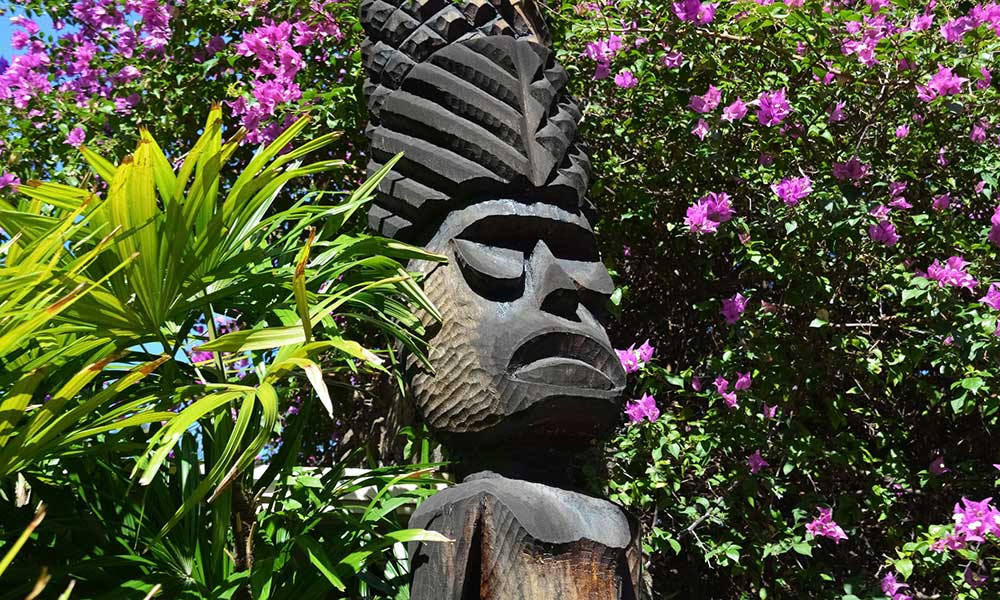Hawaiian religion encompasses a vast pantheon of gods, mythology, and religious practices.
It is protected under law and has been practiced on the islands for hundreds of years, ever since these beliefs were imported to Hawaii by early Polynesian settlers.
What Religion were the Ancient Hawaiians?
Native Hawaiian religion is animistic and polytheist, as are many native Polynesian religions.
The word “polytheist” comes from the Greek meaning “many” and “Gods”, and the first part, “Πολύ”, is the same as in “Polynesia”, which means “Many Islands”.
There are four main gods and a number of “lesser” demigods, not unlike the ancient Greek and Roman gods.
And just like those ancient European deities, everyone is connected via a vast and detailed mythology.
The Major Hawaiian Gods
There are four main Hawaiian deities:
Kane: The highest of the four major gods, Kane is the god of forests, trees, and wild foods. He is the creator and the god of procreation.
Ku: The god of war, and one of the few gods under which human sacrifice may have been practiced.
Lono: The god of peace, fertility, and agriculture. It is believed that some Hawaiians may have mistaken the explorer James Cook for Lono.
If so, this could have contributed to his eventual death at the hands of the islanders. The Makahiki festival is held in Loni’s honor.
Kanaloa: A god often represented as being complementary to Kane, like the Yin and Yang of Taoism. Kanaloa is the ruler of Mana, the lifeforce of the universe.
The Lesser Gods
In addition to the major gods outlined above, the Hawaiian people also recognized (and in many cases, continue to recognize) many lesser gods, including:
Pele: The goddess of volcanoes and fire and a very important deity for the people of Hawaii.
She is said to have been the creator of the Hawaiian islands and is referred to as “Madame Pele“.
Hina: Hina is considered to be the goddess of the moon and her name appears throughout the religions of the Pacific Islands.
Her husband is Maui, an ancient chief and warrior.
Laka: The goddess of fertility and the hula, Laka is the wife of Lono, one of the major gods.
Kuula: The god of fishermen.
Kihawahine: Often represented as a giant lizard or dragon and may be missing an eye, which was lost in a fight with Haumea, the goddess of childbirth and the mother of deities such as Pele, Kapo, and Namaka.
Papa: Papahanaumoku is a force of nature and a great healer. Often known as “earth mother”, she married Wakea, the “sky father”.
Hawaiian Mythology FAQs
To a student of history, Hawaiian religion isn’t that far removed from the mythologies created by the greatest and most influential empires in history.
But when you compare it to Christianity and Islam, it is decidedly different, and if you’re just learning about this vast and complex world, you might have a few more questions.
Take a look at these quick FAQs:
What is the Kumulipoh?
The Kumulipo is a creation chant that is rooted in the religion’s creation myth.
It is separated into sixteen different sections and describes the birth of the universe and all of its creatures, beginning with sea urchins and seaweed.
How Old Are These Beliefs?
Animism, the idea that people, places, creatures, and objects possess a spiritual essence, is said to be humanity’s oldest religion.
It’s one that you can find all over the world dating back many thousands of years.
However, we don’t know exactly when it started, nor do we know when these beliefs reached Polynesia.
What we do know is that they likely landed on the Hawaiian Islands from Tahiti and other islands between 500 AD and 1300 AD.
Do All Hawaiians Believe these Things?
Hawaiians have a unique connection to their land and history.
The island is home to many different faiths, including Christians, Jews, and Buddhists, and while they follow different belief systems and traditions, many of them have some connection to the native Hawaiian belief system.
As with other cultures around the world, some aspects of this religion are followed devoutly and others have worked their way into everyday traditions, but most Hawaiians have a deep respect for their country, its history, and the mythology that frames it.
Did they Practice Cannibalism and Human Sacrifice?
There are reports that the early Hawaiians practiced human sacrifice.
These may have been exaggerated or fabricated by the Europeans, but it’s certainly not uncommon for religions of this type to perform human sacrifice.
The idea that they were cannibals is rooted in the belief that they killed and ate James Cook, the first European explorer to encounter the Hawaiians.
They disemboweled and boiled his corpse so they could remove the bones.
Although morbid, it was a funerary practice typically reserved for elders and chiefs, suggesting that they still had a lot of respect for him.
His remains were given to his crew for burial at sea.







